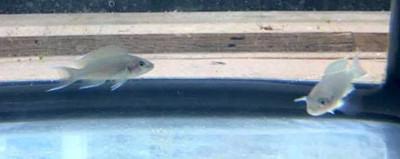Brichardi cichlid
Posted by Max Gandara on on 14th Dec 2023
The Brichardi cichlid, scientifically known as Neolamprologus brichardi,
belongs to the Cichlidae family. Native to Lake Tanganyika in East
Africa, Brichardi cichlids exhibit unique social behaviors and are
recognized for their striking appearance and interesting breeding
habits. Their genome reflects the diversity of the cichlid family,
showcasing adaptations to the specific conditions of their natural
habitat.
Brichardi cichlids are characterized by their elongated bodies, vibrant
coloration, and extended dorsal fins. In their natural habitat, they
form colonies and display intricate social structures. The species is
known for its impressive parental care, where both parents actively
participate in guarding and raising the fry.
Creating an ideal environment for Brichardi cichlids involves:
- **Tank Size:** A tank of at least 30 gallons for a small group, with more space for larger colonies.
- **Rocky Environment:** Mimic Lake Tanganyika's rocky substrate with caves and crevices for shelter.
- **Water Parameters:** Maintain alkaline water with a pH between 7.8-9.0 and a temperature of 75-80°F (24-27°C).
- **Filtration:** Use efficient filtration to maintain water quality.
- **Substrate:** Fine sand or small-grain gravel to recreate the lake's natural environment.
Companion species for Brichardi cichlids include:
**Fish:**
1. **Julidochromis Transcriptus:** Similar Lake Tanganyika cichlid, compatible in size.
2. **Lamprologus Ocellatus:** Another shell-dwelling cichlid that coexists well.
3. **Cyprichromis Leptosoma:** Schooling cichlid, occupies the upper water column.
4. **Synodontis Petricola:** Peaceful catfish, complements the cichlid community.
5. **Altolamprologus Compressiceps:** A larger cichlid that adds diversity to the tank.
**Crustaceans:**
1. **Amano Shrimp (Caridina multidentata):** Peaceful and suitable for a cichlid tank.
2. **Viper Shrimp (Atya gabonensis):** Unique appearance, cohabits well with cichlids.
3. **Mexican Dwarf Crayfish (Cambarellus patzcuarensis):** Small size, suitable for the environment.
4. **Red Claw Crab (Perisesarma bidens):** Territorial, but can cohabit with caution.
5. **Bamboo Shrimp (Atyopsis moluccensis):** Filter feeder, non-aggressive.
**Bugs:**
1. **Daphnia:** Small crustaceans, excellent live food for cichlids.
2. **Mosquito Larvae:** Natural and nutritious live food option.
3. **Bloodworms:** High in protein, a favorite of many cichlids.
4. **Brine Shrimp:** Enriched with nutrients, suitable for varied diet.
5. **Tubifex Worms:** Live or frozen, provides essential nutrients.
**Plants:**
1. **Anubias:** Hardy and can tolerate cichlid behavior.
2. **Java Fern (Microsorum pteropus):** Attaches to rocks, avoiding disturbance.
3. **Vallisneria:** Tall grass-like plant, adds vertical structure.
4. **Cryptocoryne:** Hardy and provides hiding spots for fry.
5. **Sagittaria:** Rooted plant, suitable for a sandy substrate.
**Amphibians:**
1. **African Dwarf Frog (Hymenochirus spp.):** Peaceful cohabitant in a cichlid tank.
2. **Fire-Bellied Toad (Bombina spp.):** Compatible in terms of size and habitat.
3. **African Clawed Frog (Xenopus laevis):** Aquatic, doesn't disturb cichlids.
4. **Dart Frogs (Dendrobatidae):** Terrestrial, won't interfere with cichlids' space.
5. **Mudskippers:** (Periophthalmus spp.): Brackish water species, unique addition.
These carefully chosen companions contribute to a balanced ecosystem,
promoting the well-being of Brichardi cichlids while creating an
aesthetically pleasing and dynamic aquarium.

